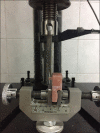Shear bond strength of different luting agents to polyether ether ketone
- PMID: 35915713
- PMCID: PMC9338352
Shear bond strength of different luting agents to polyether ether ketone
Abstract
Background: Polyether ether ketone (PEEK) was recently introduced to dentistry. However, difficulty in provision of a strong durable bond is its main drawback. Thus, precise surface treatment and use of a suitable luting agent are imperative for bonding of PEEK restorations. This study aimed to assess the effect of type of luting agent on shear bond strength (SBS) of PEEK.
Materials and methods: In this in vitro study, 60 square-shaped PEEK samples were fabricated and sandblasted with 110 μm Al2O3 particles. The samples were then divided into four groups based on the type of cement used (n = 15): zinc phosphate cement, Panavia F2, Panavia V5, and resin-modified glass-ionomer (RMGI) cement. After bonding, the samples were thermocycled for 5000 cycles. The SBS was measured by a universal testing machine. The surface of samples was inspected under a video measuring machine to determine the mode of failure. Data were analyzed using the Kruskal-Wallis test via SPSS version 24 (α = 0.05).
and methods: In this in vitro study, 60 square-shaped PEEK samples were fabricated and sandblasted with 110 μm Al2O3 particles. The samples were then divided into four groups based on the type of cement used (n = 15): zinc phosphate cement, Panavia F2, Panavia V5, and resin-modified glass-ionomer (RMGI) cement. After bonding, the samples were thermocycled for 5000 cycles. The SBS was measured by a universal testing machine. The surface of samples was inspected under a video measuring machine to determine the mode of failure. Data were analyzed using the Kruskal-Wallis test via SPSS version 24 (α = 0.05).
Results: RMGI did not bond to PEEK. The SBS values were 4.02 ± 2.87 megapascals (MPa) for Panavia V5, 10.84 ± 6.05 MPa for Panavia F2, and 10.50 ± 2.88 MPa for zinc phosphate. The SBS in the Panavia V5 group was significantly lower than that in the Panavia F2 (P = 0.001) and zinc phosphate (P < 0.001) groups. No significant difference existed between the Panavia F2 and zinc phosphate groups in this respect (P > 0.05).
Conclusion: Panavia F2 resin cement and zinc phosphate conventional cement provided the highest bond strength to PEEK, while RMGI did not bond to PEEK.
Keywords: Dental cement; glass-ionomer cement; resin cement; shear strength.
Copyright: © 2022 Dental Research Journal.
Conflict of interest statement
The authors of this manuscript declare that they have no conflicts of interest, real or perceived, financial or nonfinancial in this article.
Figures
Similar articles
-
The impact of PEEK pretreatment using H2SO4, riboflavin, and aluminum trioxide on the extrusion bond strength to canal dentin luted with Polymethyl methacrylate and resin-based composite cement.Eur Rev Med Pharmacol Sci. 2023 Oct;27(20):9639-9647. doi: 10.26355/eurrev_202310_34135. Eur Rev Med Pharmacol Sci. 2023. PMID: 37916329 Clinical Trial.
-
Effect of Luting Cements On the Bond Strength to Turkom-Cera All-Ceramic Material.Open Access Maced J Med Sci. 2018 Mar 9;6(3):548-553. doi: 10.3889/oamjms.2018.111. eCollection 2018 Mar 15. Open Access Maced J Med Sci. 2018. PMID: 29610618 Free PMC article.
-
Bonding to densely sintered alumina surfaces: effect of sandblasting and silica coating on shear bond strength of luting cements.Int J Prosthodont. 2000 May-Jun;13(3):221-6. Int J Prosthodont. 2000. PMID: 11203636
-
Poly-Ether Ether-Ketone Post Conditioned with Sulfuric Acid, Rose Bengal Activated by Photodynamic Therapy and Sandblasting on Pushout Bond Strength to Radicular Dentin Luted with Methyl Methacrylate and Composite-Based Cement.Photobiomodul Photomed Laser Surg. 2023 Oct;41(10):576-582. doi: 10.1089/photob.2023.0079. Photobiomodul Photomed Laser Surg. 2023. PMID: 37870415 Clinical Trial.
-
Effect of laser groove treatment on shear bond strength of resin-based luting agent to polyetheretherketone (PEEK).J Prosthodont Res. 2019 Jan;63(1):52-57. doi: 10.1016/j.jpor.2018.08.001. Epub 2018 Sep 13. J Prosthodont Res. 2019. PMID: 30220621
Cited by
-
Revolutionizing Dental Polymers: The Versatility and Future Potential of Polyetheretherketone in Restorative Dentistry.Polymers (Basel). 2024 Dec 31;17(1):80. doi: 10.3390/polym17010080. Polymers (Basel). 2024. PMID: 39795483 Free PMC article. Review.
References
-
- Ulgey M, Gorler O, Karahan Gunduz C. Effects of laser modalities on shear bond strengths of composite superstructure to zirconia and PEEK infrastructures: An in vitro study. Odontology. 2021;109:845–53. - PubMed
-
- Zeighami S, Mirmohammadrezaei S, Safi M, Falahchai SM. The effect of core and veneering design on the optical properties of polyether ether ketone. Eur J Prosthodont Restor Dent. 2017;25:201–8. - PubMed
-
- Najeeb S, Zafar MS, Khurshid Z, Siddiqui F. Applications of polyetheretherketone (PEEK) in oral implantology and prosthodontics. J Prosthodont Res. 2016;60:12–9. - PubMed
-
- Sloan R, Hollis W, Selecman A, Jain V, Versluis A. Bond strength of lithium disilicate to polyetheretherketone. J Prosthet Dent. DOI: 10.1016/j.prosdent.2021.02.025. [Ahead of Print] - PubMed
-
- Lieb ermann A, Wimmer T, Schmidlin PR, Scherer H, Löffler P, Roos M, et al. Physicomechanical characterization of polyetheretherketone and current esthetic dental CAD/CAM polymers after aging in different storage media. J Prosthet Dent. 2016;115:321–8. - PubMed
LinkOut - more resources
Full Text Sources
Miscellaneous



